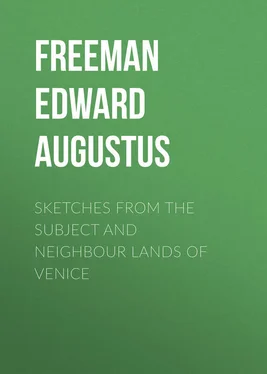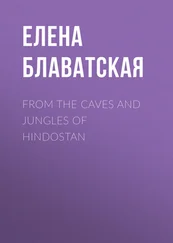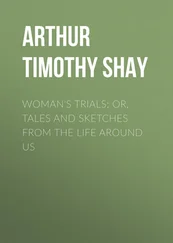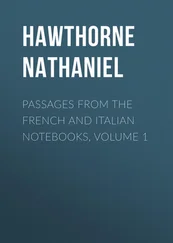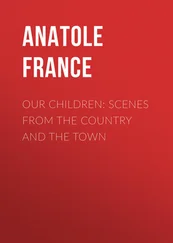Edward Freeman - Sketches from the Subject and Neighbour Lands of Venice
Здесь есть возможность читать онлайн «Edward Freeman - Sketches from the Subject and Neighbour Lands of Venice» — ознакомительный отрывок электронной книги совершенно бесплатно, а после прочтения отрывка купить полную версию. В некоторых случаях можно слушать аудио, скачать через торрент в формате fb2 и присутствует краткое содержание. Жанр: foreign_antique, foreign_prose, Путешествия и география, на английском языке. Описание произведения, (предисловие) а так же отзывы посетителей доступны на портале библиотеки ЛибКат.
- Название:Sketches from the Subject and Neighbour Lands of Venice
- Автор:
- Жанр:
- Год:неизвестен
- ISBN:нет данных
- Рейтинг книги:3 / 5. Голосов: 1
-
Избранное:Добавить в избранное
- Отзывы:
-
Ваша оценка:
- 60
- 1
- 2
- 3
- 4
- 5
Sketches from the Subject and Neighbour Lands of Venice: краткое содержание, описание и аннотация
Предлагаем к чтению аннотацию, описание, краткое содержание или предисловие (зависит от того, что написал сам автор книги «Sketches from the Subject and Neighbour Lands of Venice»). Если вы не нашли необходимую информацию о книге — напишите в комментариях, мы постараемся отыскать её.
Sketches from the Subject and Neighbour Lands of Venice — читать онлайн ознакомительный отрывок
Ниже представлен текст книги, разбитый по страницам. Система сохранения места последней прочитанной страницы, позволяет с удобством читать онлайн бесплатно книгу «Sketches from the Subject and Neighbour Lands of Venice», без необходимости каждый раз заново искать на чём Вы остановились. Поставьте закладку, и сможете в любой момент перейти на страницу, на которой закончили чтение.
Интервал:
Закладка:
Edward A. Freeman
Sketches from the Subject and Neighbour Lands of Venice
PREFACE
This volume is designed as a companion and sequel to my former volume called "Architectural and Historical Sketches, chiefly Italian." Its general plan is the same. But more of the papers in the present volume appear for the first time than was the case with the earlier one, and most of those which are reprinted have been more largely changed in reprinting than those which appeared in the former book. This could hardly be otherwise with the pieces relating to the lands east of the Hadriatic, where I have had to work in remarks made during later journeys, and where great events have happened since I first saw those lands.
The papers are chiefly the results of three journeys. The first, in the autumn of 1875, took in Dalmatia and Istria, with Trieste and Aquileia. At that time the revolt of Herzegovina had just begun, and Ragusa was crowded with refugees. Some of the papers contained references to the state of things at the moment, and those references I saw no reason to alter. But I may as well say that the time of my first visit to the South-Slavonic lands was not chosen with reference to any political or military object. The journey was planned before the revolt began; it was in fact the accomplishment of a thirty years' yearning after the architectural wonders of Spalato, which till that year I had been unable to gratify. If that visit taught me some things with regard to our own times as well as to earlier times, it is not, I think, either wonderful or blameworthy.
In 1877 I visited Dalmatia for the second time, and Greece for the first. I should be well pleased some day to put together some out of many papers on the more distant Greek lands. In this volume I have brought in those on Corfu only, as that island forms an essential part of my present subject.
In the present year 1881 I again visited Dalmatia and some parts of Istria and Albania, as also a large part of Italy. This has enabled me to add some papers on the Venetian possessions both in northern and southern Italy, as also one on the Dalmatian island of Curzola, which on former visits I had seen only in passing.
The papers headed "Treviso," "Gorizia," "Spalato revisited," "Trani," "Otranto," "Corfu to Durazzo," and "Antivari," are all due to this last journey, and have never been in print before. That on "Curzola" appeared in Macmillan's Magazine for September 1881. Those headed "Udine and Cividale," "Aquileia," "Trieste to Spalato," "Spalato to Cattaro," "A trudge to Trebinje," appeared in the Pall Mall Gazette in 1875. The rest appeared in the Saturday Review in 1875 and 1876. But many of them have been so much altered that they can hardly be called mere reprints; they are rather recastings, with large additions, omissions, and changes, such as the light of second and third visits seemed to call for.
I made none of these journeys alone, and I have much for which to thank the companions with whom I made them. In 1877 I was with the Earl of Morley and Mr. J. F. F. Horner. And I must not forget to mention that it was Lord Morley who at once read and explained the inscription in the basilica of Parenzo, when Mr. Horner and I had seen that Mr. Neale's explanation was nonsense, but had not yet hit upon anything better for ourselves. In a great part of my two later journeys I had the companionship of Mr. Arthur Evans, my friend of 1877, my son-in-law of 1881. How much I owe to his knowledge of South-Slavonic matters, words would fail me to tell. I had seen Dalmatia for the first time, and I had begun to write about it, before I knew him and, I believe, before he had published anything; otherwise I should almost feel myself an intruder in a province which he has made his own. One out of many points I may specially mention. It was Mr. Evans who found and explained the two missing capitals from the palace at Ragusa, which are at once so remarkable in themselves and which throw so much light on the history of the building.
The illustrations to my former volume met with some severe criticism. But I am bound to say that of that severe criticism I agreed to every word. Only I thought that the critics would perhaps have been less severe if they had seen my original drawings themselves. The illustrations to the present volume have been made by a new process, partly, as before, from my own sketches, but partly also from photographs. I trust that they will be found less unsatisfactory than those that went before them.
As there are in these papers a good many historical references, some of them to rather out-of-the-way matters, but matters which could not always be explained at length in the text, I have drawn up a chronological table of the chief events in the history of the lands and cities of which I have had to speak.
I need hardly say that this volume, though I hope it may be useful to travellers on the spot, is not strictly a guide-book. But a good guide-book to Istria and Dalmatia is much needed. I am not joking when I say that the best guide to those parts is still the account written by the Emperor Constantino Porphyrogenitus more than nine hundred years back. But it is surely high time that there should be another. The attempts made in one or two of Murray's Handbooks are very poor. Sir Gardner Wilkinson's "Dalmatia and Montenegro," published more than thirty years ago, is an admirable book, and one to which I owe a very deep debt of gratitude. It first taught me what there was to see in the East-Hadriatic lands. But it is over-big for a guide-book. Mr. Neale's book contains some information, and, even in its ecclesiastical grotesqueness, it is sometimes instructive as well as amusing. But we can hardly take as our guide one who leaves out the Ragusan palace and who, when at Spalato, does not think of Diocletian. It would be in itself well if Gsel-fels, the prince of guide-book-makers, would do for Dalmatia as he has done for Sicily; but one would rather see it done in our own tongue.
Somerleaze, Wells,
September 20th, 1881 .
CHRONOLOGICAL TABLE

THE LOMBARD AUSTRIA
TREVISO
The north-eastern corner of Italy is one of those parts of the world which have gone through the most remarkable changes. That it has often changed its political masters is only common to it with the rest of Italy, and with many other lands as well. The physical changes too which the soil and its waters have gone through are remarkable, but they are not unparalleled. The Po may perhaps be reckoned as the frontier stream of the region towards the south, and the many paths by which the Po has found its way into the Hadriatic need not be dwelled on. We are more concerned with rivers further to the north-east. The Isonzo no longer represents the course of the ancient Sontius; the Natisone no longer flows by fallen Aquileia. The changes of the coast-line which have made what is left of Aquileia inland have their counterparts at Pisa and at Ravenna. In the range of historical geography, the most curious feature is the way in which certain political names have kept on an abiding life in this region, though with singular changes of meaning. The land has constantly been either Venetian or Austrian; sometimes it has been Venetian and Austrian at once. But it has been Venetian and Austrian in various meanings. It was Venetian long before the name of Venice was heard of in its present sense; it was Austrian long before the name of Austria was heard of in its present sense. The land of the old Veneti bore the Venetian name ages before the city of Venice was in being, and it keeps it now that Venice has ceased to be a political power. Venetian then the land has ever been in one sense, while a large part of it was for some centuries Venetian in another sense, in the days when so many of its cities bowed to Saint Mark and his commonwealth as its rulers. Austrian the land was in the old geographical sense, when it formed the Lombard
Читать дальшеИнтервал:
Закладка:
Похожие книги на «Sketches from the Subject and Neighbour Lands of Venice»
Представляем Вашему вниманию похожие книги на «Sketches from the Subject and Neighbour Lands of Venice» списком для выбора. Мы отобрали схожую по названию и смыслу литературу в надежде предоставить читателям больше вариантов отыскать новые, интересные, ещё непрочитанные произведения.
Обсуждение, отзывы о книге «Sketches from the Subject and Neighbour Lands of Venice» и просто собственные мнения читателей. Оставьте ваши комментарии, напишите, что Вы думаете о произведении, его смысле или главных героях. Укажите что конкретно понравилось, а что нет, и почему Вы так считаете.
